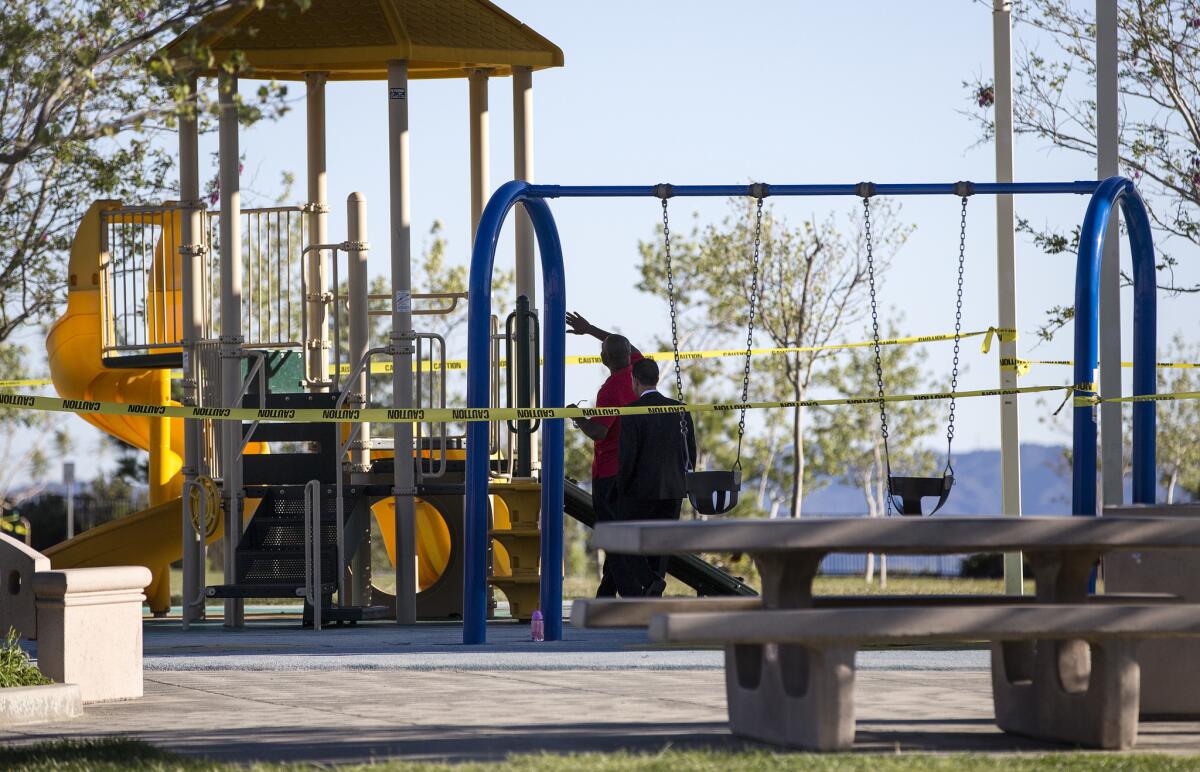Oily slime from Porter Ranch well temporarily closes nearby park

L.A. City Councilman Mitch Englander, right, inspects playground equipment with a park official after Holleigh Bernson Memorial Park was closed because an oily residue was found on the playground in Porter Ranch.
- Share via
A park in Porter Ranch was closed Tuesday after city officials discovered playground equipment covered in an oily residue that likely came from a leaking well in Aliso Canyon.
The playground at Holleigh Bernson Memorial Park had been given the all-clear by county health officials Sunday, but staff members with Councilman Mitch Englander’s office revisited the park Tuesday and found the small brown droplets of oil, which can cause skin irritations.
The park was temporarily closed so crews with the Southern California Gas Co. could clean the equipment.
Crews are expected to clean Palisades Park, Viking Park and Porter Ranch Park tomorrow, according to the gas company.
NEWSLETTER: Get essential California headlines delivered daily >>
County health officials visited the park this weekend after receiving complaints about the oily residue. But after inspecting “playground equipment, picnic tables, baseball field bleachers, drinking fountains, restrooms, and walkways,” officials determined “no visible oily residue on any of these surfaces,” according to a statement from the Environmental Health Division.
“It certainly brings into question exactly what methods they’re using and how they’re making these determinations,” Englander said. “Certainly even a visual check will tell you it’s there.”
Several hours before the playground was closed, a spokeswoman with the Department of Parks and Recreation said there had not been any complaints about oil on the swings, slide and other equipment.
“At this point, with everything we’ve been through and this community has been through, I’m not taking anybody’s word,” Englander said.
The oil is likely from SS-25 in Aliso Canyon, a well that caused the largest methane leak in U.S. history. The leak was first reported Oct. 23. Crews began drilling a relief well in December and ultimately capped the leak Feb. 18.
Thousands of households in Porter Ranch and surrounding communities temporarily relocated to get away from the smell of the gas leak, which was described as rotten eggs. Two public schools were relocated and small businesses saw their customers disappear.
Many residents suffered from headaches, upset stomachs and nosebleeds during the leak. Health officials blamed mercaptans, an odorant added to the methane, for those symptoms.
In January, gas crews installed mesh screens in Aliso Canyon to prevent an oily mist from flowing out of the canyon and into the nearby community. Now that families are returning to their homes, many are finding the oil droplets on their homes and cars that may have fallen before the screens were installed.
The gas company announced this week it would assess and clean at least 140 homes covered in the residue.
In the weeks since officials from 10 local and state agencies stood next to SoCalGas executives to announce that leak had been sealed, more than 150 people have complained of continued problems with headaches, upset stomachs and skin irritations.
The Los Angeles County Department of Public Health received 150 health complaints from residents returning home between Feb. 18 and March 3, according to a new report. During the 16 weeks that the well was leaking, the department received a total of 700 complaints.
It is unclear why returning residents are still feeling ill, according to the department.
As of March 6, 2,706 households remained in temporary accommodations. SoCalGas will stop paying the expenses of relocated families on March 18, a date the gas company was forced to accept after attorneys for Los Angeles County took legal action to provide customers with more time to move home.
On Tuesday, County Counsel Mary Wickham told the Board of Supervisors it may file for another extension if the experts in the field find “pertinent issues” that would warrant it.
Two air quality agencies are continuing to monitor the Porter Ranch community. Data from the South Coast Air Quality Management District found methane levels there exceeded 3 parts per million on at least seven days at multiple different locations after the leaking well was repaired.
Residual methane in the soil near the well may have caused the spikes at some of those locations but the cause of the other readings is “unclear,” according to AQMD. The agency and the state Air Resources Board are investigating.
[email protected] | Twitter: @TheCityMaven
ALSO
Oil and gas firm reactivates long-idle wells near L.A. school after residents seek to plug them
Mudslide probably caused Bay Area commuter train derailment, railroad official says
How an emergency declaration over L.A.’s homeless became a game of ‘hot-potato keep-away’
More to Read
Sign up for Essential California
The most important California stories and recommendations in your inbox every morning.
You may occasionally receive promotional content from the Los Angeles Times.











